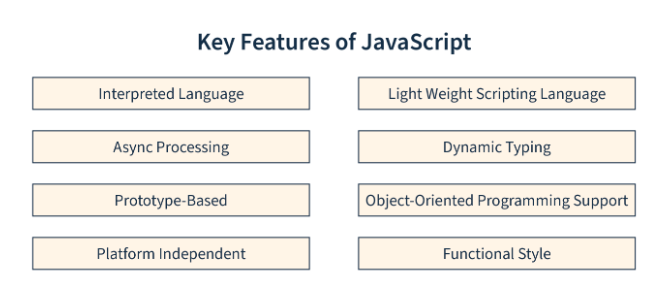
JavaScript is a versatile programming language, which has become an integral part of web development for creating dynamic and interactive websites. The versatility of JavaScript extends to various frameworks for enhancing user experience. In this article, we will explore the 10 important applications of JavaScript, exploring why it has gained such immense popularity and how it is used across various domains.
Why is JavaScript So Popular?
JavaScript provides a combination of features and capabilities that make it a preferred language for web development. Here are the key features that contribute to the widespread javascript use:

- JavaScript ensures a uniform user experience on diverse platforms by offering cross-browser compatibility with support for all major web browsers.
- JavaScript is a client-side scripting language, which is used to add real-time updates and responsiveness for creating dynamic and interactive user interfaces.
- The language supports asynchronous programming, allowing tasks to be executed independently without blocking the main program flow.
- JavaScript has multiple libraries and frameworks, including but not limited to React, Vue.js, and Angular. These frameworks speed up development by simplifying complex tasks.
- JavaScript is also been used in server-side development through Node.js. Developers can now use a single programming language, JavaScript, for both client and server.
- Provides native support for JSON, which simplifies data interchange between the server and the client as JSON has become the standard data format for web APIs.
- JavaScript is a dynamically-typed language, where variables can change types during runtime. This allows flexibility in coding practices.
- Follows an event-driven programming model, responding to user actions or system events. This model contributes to a more engaging user experience.
- JavaScript allows dynamic content updates without requiring full-page reloads in Single Page Applications (SPA), providing a smoother and more responsive user experience.
- Its ability to manipulate the Document Object Model (DOM) in real-time allows applications to provide interactive features and dynamic data rendering. This contributes significantly to the overall fluidity and responsiveness of web applications.
Practical Applications of JavaScript
Web Development
- The javascript use is in modern web development as it is part of multiple frameworks and can create responsive and dynamic user interfaces.
- Frameworks like React, Angular, and Vue.js use JavaScript to build reusable components, manage state, and enhance the user experience by facilitating real-time updates without the need for full-page reloads.
Mobile App Development
- JavaScript is also used in cross-platform mobile app development, offering developers to use a single codebase for both iOS and Android platforms.
- Frameworks like React Native and PhoneGap enable the use of JavaScript to build mobile applications. Since React Native is similar to React, developers can use their React skills across both platforms, enhancing efficiency and code reusability.
Server-Side Development
Node.js, a JavaScript runtime allows developers to use JavaScript for server-side scripting, enhancing the efficiency and performance of web applications.
Browser Game Development
- JavaScript use can also be the creation of engaging browser-based games.
- Libraries like Phaser utilize JavaScript to handle game logic, graphics, and user input. This enables the development of engaging and interactive games directly within web browsers.
Web APIs Integration
- JavaScript facilitates seamless integration with various web APIs, enabling the creation of feature-rich applications by leveraging external services.
- AJAX (Asynchronous JavaScript and XML) is commonly used to make asynchronous requests to APIs. Frameworks like NestJs are also used to build API easily.
Interactive Maps
Services like Google Maps use JavaScript APIs to embed maps on websites, allowing users to explore locations, get directions, and interact with map elements seamlessly.
Smartwatch Apps
- JavaScript use is utilized for developing applications for smartwatches, enhancing user experiences on wearable devices.
- Frameworks like Pebble.js, allow developers to create cross-platform smartwatch apps.
Flying Robots
- JavaScript is employed in programming the behavior of flying robots, such as drones.
- Node.js, combined with libraries like Cylon.js, enables developers to control the flight and functionality of drones using JavaScript.
Presentations
- Dynamic and interactive presentations can be created using JavaScript use.
- Presentation frameworks like Reveal.js and Bespoke.js leverage JavaScript to enable features like slide transitions, animations, and interactive elements.
Web Animations
- Visually amazing animations, enhancing the overall aesthetic of websites and applications can be created using JavaScript use.
- Libraries and frameworks like GSAP (GreenSock Animation Platform) and Three.js use JavaScript to handle complex animations, 3D graphics, and interactive visual elements, enhancing the overall aesthetic of web projects.
Must-have Skills for JavaScript Developers
To start a career as a JavaScript developer, one must acquire essential skills. Becoming a proficient JavaScript developer requires a comprehensive skill set that goes beyond just knowing the syntax of the language. Here are the major job skills required for a JavaScript developer:
- Proficiency in JavaScript:
A strong command of JavaScript fundamentals, including data types, functions, objects, and asynchronous programming, is essential. - HTML and CSS:
For manipulation and interaction with the Document Object Model (DOM). - Front-End Frameworks (React, Angular, Vue.js):
Knowledge of popular front-end frameworks essential for building dynamic and scalable user interfaces. - Node.js and Back-End Development:
To use JavaScript on the server side, including server-side scripting, handling databases, and creating RESTful APIs. - Asynchronous Programming:
The fundamental aspect of web development for handling asynchronous operations. - Version Control/Git:
For tracking changes, collaborating with teams, and managing code repositories efficiently. - Package Managers (npm, Yarn):
For managing project dependencies, installing libraries, and maintaining a consistent development environment. - Testing and Debugging:
Proficiency in testing frameworks (e.g., Jest, Mocha) and debugging tools is crucial for ensuring the reliability and quality of JavaScript code. - Build Tools (Webpack, Babel):
For automating tasks, bundling code, and transpiling modern. - Responsive Design and Cross-Browser Compatibility:
For delivering a consistent user experience across various devices and browsers.
Conclusion
- JavaScript's cross-browser compatibility and dynamic capabilities make it a vital language for web development. JavaScript's dynamic nature allows developers to create interactive and responsive user interfaces with better management of asynchronous operations.
- Its popularity is driven by client-side scripting, asynchronous programming, and a rich ecosystem of frameworks like React and Angular that provides developers with pre-built components and structured architectures, for faster development.
- Practical applications range from web and mobile development to server-side scripting, gaming, and real-time chat applications. JavaScript also finds applications in creating smartwatch apps, programming flying robots, and enhancing interactive presentations.
- Essential skills for developers include proficiency in JavaScript, knowledge of front-end frameworks, and expertise in back-end development, alongside effective use of tools like Git, and npm. A better understanding of build tools like Babel and Webpack is also important.